來源:WCCF Tech
點擊此處查看原文>>>
AMD Ryzen 7000 Desktop CPUs
2H 2022Manufacturer
AMDType
CPUPlatforms
AM5Expected Price
TBAExpected Release Date
2H 2022AMD officially lifted the curtains off its next-generation Ryzen 7000 Dekstop CPUs that are going to feature the Zen 4 core architecture atCES 2022 & Computex 2022. The next-generation lineup will be bringing some drastic changes, not only limited to the CPU and we are going to talk about what you can expect in terms ofspecifications, performance, and prices.
AMD Ryzen 7000 'Zen 4' Desktop CPUs, The First 5nm Consumer CPUs For The Latest AM5 Platform
[Updated - 07/08/22]
While Intel may have managed to take the performance, value, and efficiency throne from AMD with its12th Gen Alder Lake lineup, AMD isn't going to sit silent. They have planned two brand new CPU launches this year with the upcoming one being ademonstration of how 3D V-Cachecan allow gamers to benefit from faster performance in a mainstream package. But that's just one chip, the bigger launch is scheduled for the second half of 2022 in the form of Ryzen 7000 and it's going to fundamentally change everything for the Ryzen Desktop CPU platform.
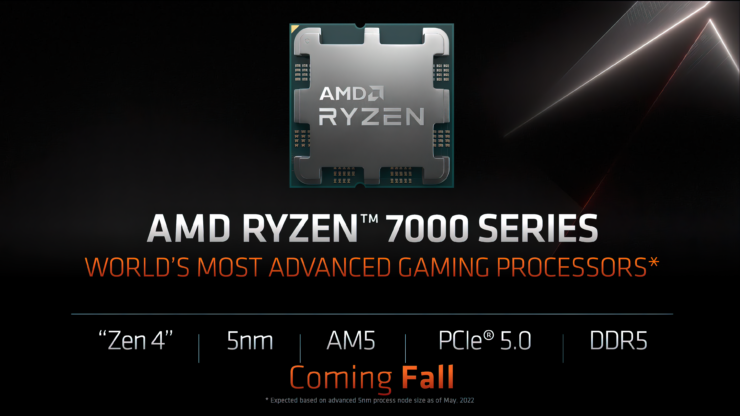
AMD Ryzen 'Zen 4' Desktop CPU Expected Features:
- Up To 16 Zen 4 Cores and 32 Threads
- Over 15% Performance Uplift In Single-Threaded Apps
- Brand New Zen 4 CPU Cores (IPC / Architectural Improvements)
- Brand New TSMC 5nm process node with 6nm IOD
- 25% Performance Per Watt Improvement Vs Zen 3
- >35% Overall Performance Improvement Vs Zen 3
- 8-10% Instructions Per Clock (IPC) Improvement Vs Zen 3
- Support on AM5 Platform With LGA1718 Socket
- New X670E, X670, B650E, B650 Motherboards
- Dual-Channel DDR5 Memory Support
- Up To DDR5-5600 Native (JEDEC) Speeds
- 28 PCIe Lanes (CPU Exclusive)
- 105-120W TDPs (Upper Bound Range ~170W)
AMD AM5 Platform - A New Beginning
Before we talk CPUs, we have to talk about the platform itself. The AMD Ryzen 7000 CPUs will be migrating to anew home known as AM5, the successor to the long-lasting AM4 platform. It marks a fresh start for the Ryzen Desktop family and as such, existing Ryzen CPUs starting with Ryzen 1000 & all the way up to Ryzen 5000 won't be supported by the new platform and we will tell you why it is so.
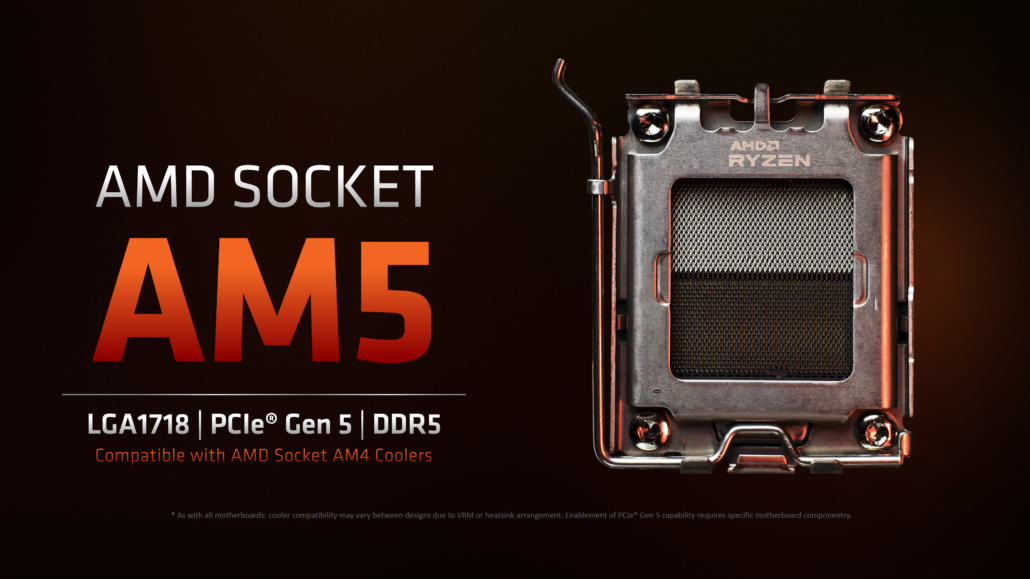
The AM5 platform will first and foremost feature the brand new LGA 1718 socket. That's correct, AMD isn't going the PGA (Pin Grid Array) route anymore and now focusing on LGA (Land Grid Array), similar to what Intel uses on its existing desktop processors. The main reason to go LGA is due to the addition of enhanced and next-gen features such as PCIe Gen 5, DDR5, etc that we will get to see on the AM5 platform. The socket has a single latch & gone are the days of worrying about pins underneath your precious processors.
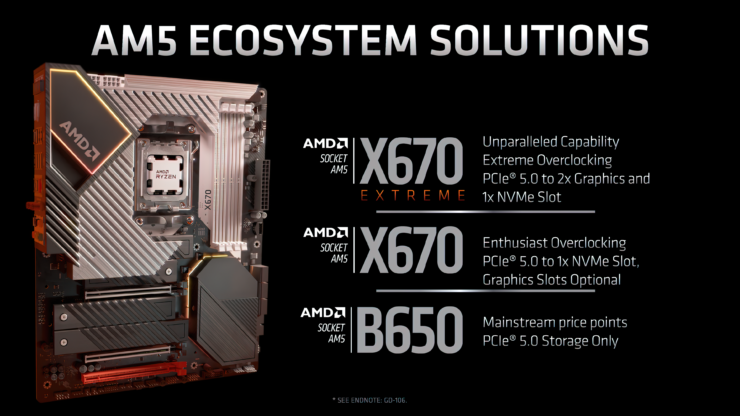
In terms of features, the AM5 platform will initially support AMD's Ryzen 7000 'Zen 4' Desktop CPUs and extend that support to future Ryzen CPUs and APUs. The platform offers DDR5-5200 (JEDEC) memory support, up to 28 PCIe lanes (Gen 5 standard), increased NVMe 4.0, and USB 3.2 I/O lanes & we have also heard chatter about native USB 4.0 support which will be a game-changer.
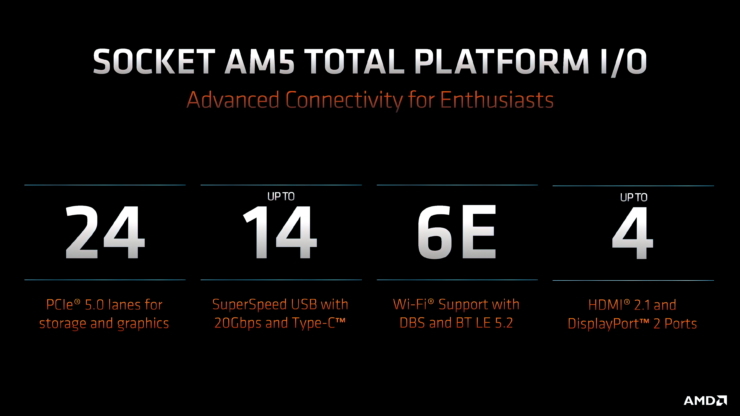
A new feature called EXPO (AMD Extended Profiles for overclocking) will allow enhanced DDR5 memory OC on the new platform, similar to Intel's XMP. It has been a rough road for AM4 to offer decent DDR4 OC capabilities but that has more or less been sorted out by now, we can only expect DDR5 to have a much better OC and compatibility experience compared to DDR4 on AM4 platforms. Furthermore, it looks like the platform will only be DDR5 compatible and we won't see DDR4 options as we do on Intel's existing platform. But with DDR5 prices and availability improving, that won't be that big of a deal for most high-end consumers for who AMD will be aiming first.
AMD X670 Series Platform
The AM5 compliant AMD 600-series motherboards are currently being prepped up by the board makers, The 600-series lineup will initially consist of three chipsets, the X670E, X670, B650E, and B650.
In terms of features, the X670E (Extreme) is designed for the higher-echelon of motherboards with unparalleled capabilities, and extreme overclocking, and will have PCIe 5.0 support for both GPU and storage.
The X670 motherboards will be very similar in offering enthusiast-level overclocking but PCIe Gen 5.0 support for storage and graphics will depend on manufacturers. It is likely that some board makers will go to the cost-effective route and enable PCIe 5.0 support only for the GPU while keeping storage limited to PCIe 4.0. Both X670 chipsets will come in a dual-PCH solution on the motherboard to allow for the increased I/O for the next-gen platform.
AMD B650 Series Platform
Finally, there are the B650E & B650 chipsets which will be aimed as a mainstream motherboard solution with the Extreme series featuring both PCIe Gen 5.0 and M.2 while the non-E boards will adopt only PCIe 5.0 slot designs.
The B650 motherboards will be the successor to the B550 motherboards and come in a similar price range. Compared to the X670/E offerings, the B650 chipset will come in a single PCH design. The motherboards will carry support for RDNA 2 iGPU too which will be featured on Ryzen 7000 'Raphael' CPUs and offer both HDMI / DP outputs.
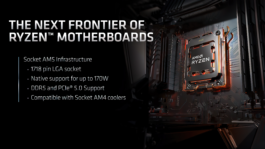

One of the highlighted features of the AMD AM5 600-series platform is SAS or Smart Access Storage. This technology will enable GPU decompression with supported Microsoft DirectStorage games. Although there aren't many of those out there yet but expect industry-wide support for this on newer platforms.
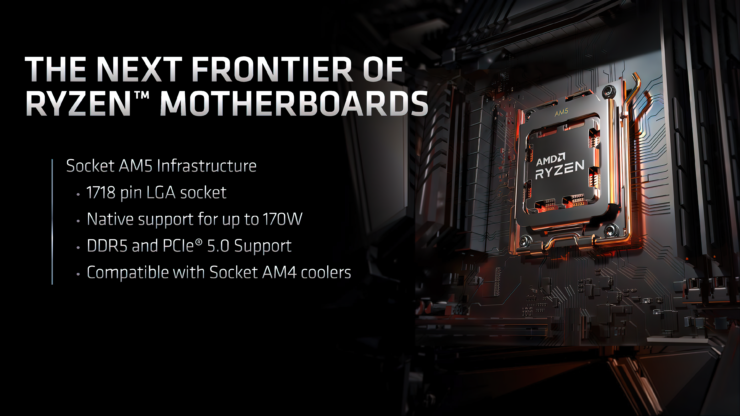
As for longevity, AMD hasn't promised anything but they havestated that they want to see the new AM5 socket last at least four to five years, similar to AM4. While there has been a lot of controversy regarding Ryzen support on the initial AM4 motherboards, I believe that AMD has learned and will not follow the same route with AM5. With that said, the AM4 platform will still continue forward & will be supported in the foreseeable future (possibly with newer hardware and software launches).
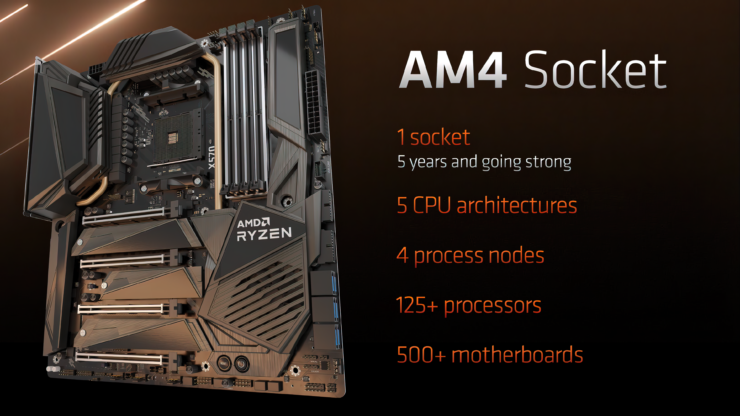
SmartAccess Storage gets you out of the load screen and into your gameplay
Traditional game loading takes a significant amount of compute power to decompress the game’s data, requiring the CPU to do the decompression and data transfer, which introduces latency and takes up considerable system resources.
To help bypass these bottlenecks, AMD has created SmartAccess Storage, a suite of technologies supporting Microsoft DirectStorage that utilizes Smart Access Memory with new AMD platform technologies along with Radeon GPU asset decompression to improve both game load times and texture streaming.
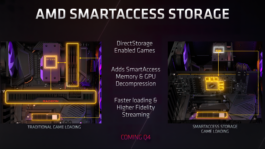

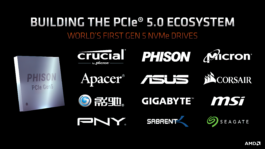
AMD AM4/TR4 Chipset Features and Specifications:
| Wccftech | X670E/X670 | X570 | X399 Refresh | X399 | X470 | X370 | B450 | B350 | A320 | X300 | A300 |
|---|---|---|---|---|---|---|---|---|---|---|---|
| CrossfireX/SLI | Triple CFX/2-Way SLI | Triple CFX/2-Way SLI | Quad SLI/CFX(Max 6 GPU Support) | Quad SLI/CFX(Max 6 GPU Support) | Triple CFX/2-Way SLI | Triple CFX/2-Way SLI | N/A | N/A | N/A | N/A | N/A |
| PCIe Gen 5 Lanes | 24 (with Ryzen 7000 CPUs & above) | N/A | N/A | N/A | N/A | N/A | N/A | N/A | N/A | N/A | N/A |
| PCIe Gen 3/4 Lanes | TBD | 30 +16 (with Ryzen 7 CPU) | 60 (With Threadripper CPU)4 Lanes Reserved for PCH | 60 (With Threadripper CPU)4 Lanes Reserved for PCH | 16 (with Ryzen 7 CPU) | 16 (with Ryzen 7 CPU)8 (with Bristol Ridge) | 16 (with Ryzen 7 CPU) | 16 (with Ryzen 7 CPU)8 (with Bristol Ridge) | 16 (with Ryzen 7 CPU)8 (with Bristol Ridge) | 16 (with Ryzen 7 CPU)8 (with Bristol Ridge) | 16 (with Ryzen 7 CPU)8 (with Bristol Ridge) |
| PCIe Gen 2 Lanes | N/A | N/A | 8 PCIe Lanes (reserved) | 8 PCIe Lanes (reserved) | 8 (plus x2 PCIe Gen3 when no x4 NVMe) | 8 (plus x2 PCIe Gen3 when no x4 NVMe) | 6 (plus x2 PCIe Gen3 when no x4 NVMe) | 6 (plus x2 PCIe Gen3 when no x4 NVMe) | 4 (plus x2 PCIe Gen3 when no x4 NVMe) | 4 (plus x2 PCIe Gen3 when no x4 NVMe) | 4 (plus x2 PCIe Gen3 when no x4 NVMe) |
| USB 3.1/3,2 Gen2 | TBD | 8 | 2 | 2 | 2 | 2 | 2 | 2 | 1 | 0 | 0 |
| USB 3.1/3.2 Gen1 | TBD | 12 (PCH + CPU) | 13 (PCH+CPU) | 13 (PCH+CPU) | 10 | 10 | 6 | 6 | 6 | 4 | 4 |
| USB 2.0 | TBD | N/A | 6 | 6 | 6 | 6 | 6 | 6 | 6 | 0 | 0 |
| SATA 6Gb/s | 8 | 8 | 8 | 8 | 6 | 6 | 4 | 4 | 4 | 2 | 2 |
| SATA Express | TBD | 2 | 2 | 2 | 2 | 2 | 2 | 2 | 2 | 1 | 1 |
| DDR5 DIMMs | 4 | N/A | N/A | N/A | N/A | N/A | N/A | N/A | N/A | N/A | N/A |
| DDR4 DIMMs | N/A | 4 | 8 | 8 | 4 | 4 | 4 | 4 | 2 | 2 | 2 |
| OverclockingSupport | Yes | Yes | Yes | Yes | Yes | Yes | Yes | Yes | No | Yes | No |
| XFR2 Enhanced | Yes | Yes | Yes | No | Yes | No | Yes | No | No | No | No |
| Precision Boost Overdrive | Yes | Yes | Yes | No | Yes | No | Yes | No | No | No | No |
| NVMe | Yes (Gen 5.0) | Yes | Yes | Yes | Yes | Yes | Yes | Yes | Yes | Yes | Yes |
| Form Factor | ATX | ATX, MATX | ATX, MATX | ATX, MATX | ATX, MITX | ATX | ATX, M-ATX | ATX, M-ATX | M-ATX, Mini-ITX | Mini-ITX | M-ATX, Mini-ITX |
AMD Ryzen 7000 'Zen 4 Raphael' CPUs Specifications
Coming to the CPUs now, we have managed to get hold of thefinal specifications of AMD's Ryzen 7000 Desktop CPU familywhich, as expected, are going to feature four SKUs based on the Zen 4 core architecture. Once again, these SKUs include:
- AMD Ryzen 9 7950X
- AMD Ryzen 9 7900X
- AMD Ryzen 7 7700X
- AMD Ryzen 5 7600X
So before getting into the core specifications, we have to point out that the AMD Zen 4 architecture brings with it a 8-10% IPC uplift but the majority of the performance benefit comes from the higher clock speeds and a higher TDP that is supplemented to each chip versus the prior generation. AMD has highlighted a >15% Single-Threaded, >35% Multi-Threaded and >25% Perf/Watt increases when comparing Zen 4 to Zen 3 cores.
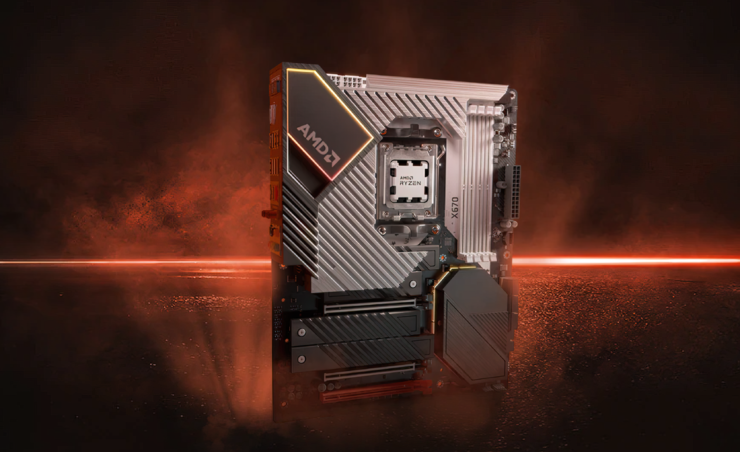
The CPUs will come with an optimized cache restructuring, featuring double the L2 cache (1 MB vs 512 KB), a shared L3 cache like the previous generation, support for DDR5 memory with EXPO (AMD's Extended Profiles For Memory Overclocking), PCIe Gen 5.0 graphics card, and M.2 SSD support. So with all of that said, let's get on with the specifications.
AMD Ryzen 9 7950X 16 Core "Zen 4" Desktop CPU
Starting with the flagship of them all, we have the AMD Ryzen 9 7950X which retains its healthy 16 core and 32 thread count from the previous two generations. The CPU will feature an impressive base frequency of 4.5 GHz and a boost clock of up to 5.7 GHz which should make it 200 MHz faster than Intel's Alder Lake Core i9-12900KS which has a boost frequency of 5.5 GHz on a single-core. It looks like AMD is extracting every ounce of Hertz that it could within that 170W TDP (230W PPT) for the Ryzen 9 chips. As for the cache, the CPU comes with 80 MB of that which includes 64 MB from L3 (32 MB per CCD) and 16 MB from L2 (1 MB per core).
We don't know the pricing or performance of the Ryzen 9 7950X yet but based on the clocks alone, it should be a worthy successor to the Ryzen 9 5950X and will easily be able to topple Intel's current Core i9-12900K CPU.
AMD Ryzen 9 7900X 12 Core "Zen 4" Desktop CPU
Next up, we have another AMD Ryzen 9 chip, the 7900X, which as the name suggests, would come equipped with 12 cores and 24 threads. The CPU comes with an even higher base clock of 4.7 GHz and a boost clock adjusted at 5.6 GHz across a single core. The CPU retains its 170W TDP and gets 76 MB of cache (64 MB L3 + 12 MB L2). The CPU will be positioned in the same ballpark as the AMD Ryzen 9 5900X but with performance that would shake the ground from below the Core i7-12700K.
AMD Ryzen 7 7700X 8 Core "Zen 4" Desktop CPU
Moving over to the Ryzen 7 family, here we have the AMD Ryzen 7 7700X, an 8-core and 16-thread part. AMD positions this as the sweet spot for gamers and as such, the CPU will feature base clock of 4.5 GHz and a boost clock of 5.4 GHz but at a lower 105W TDP (142W PPT). The CPU will get a 40 MB cache pool which consists of 32 MB L3 from the singular CCD &8 MB L2 from the Zen 4 cores.
Now one interesting thing to mention is that there is so far no update by AMD on a Ryzen 7 7800X chip. It is likely that AMD wants to replace that part with a successor to the Ryzen 7 5800X3D with Zen 4 cores (3D V-Cache). If that was the case, we can expect an update later this year to the CPU lineup since the
AMD Ryzen 5 7600X 6 Core "Zen 4" Desktop CPU
Last up, we have the most budget-tier chip (if you can call it that but the pricing won't be reflective of that), the Ryzen 5 7600X. This will be a 6-core and a 12-thread part that features a high 4.7 GHz base clock and a 5.3 GHz single-core boost frequency. The CPU will also run at a 105W TDP (142W PPT) which is much higher than its 65W predecessor though once again, that's the sacrifice you've to pay to achieve the faster clock speeds. The CPU will carry 38 MB of cache that comes from 32 MB of L3 and 6 MB of L2 on the die.
AMD Ryzen 7000 'Raphael' Desktop CPU Specs:
| CPU Name | Architecture | Process Node | Cores / Threads | Base Clock | Boost Clock (SC Max) | Cache | TDP | Prices (TBD) |
|---|---|---|---|---|---|---|---|---|
| AMD Ryzen 9 7950X | Zen 4 | 5nm | 16/32 | 4.5 GHz | 5.7 GHz | 80 MB (64+16) | 170W | >$799 US |
| AMD Ryzen 9 7900X | Zen 4 | 5nm | 12/24 | 4.7 GHz | 5.6 GHz | 76 MB (64+12) | 170W | >$599 US |
| AMD Ryzen 7 7800X | Zen 4 | 5nm | 8/16 | TBD | TBD | TBD | TBD | >$449 US |
| AMD Ryzen 7 7700X | Zen 4 | 5nm | 8/16 | 4.5 GHz | 5.4 GHz | 40 MB (32+8) | 105W | ~$299 US |
| AMD Ryzen 5 7600X | Zen 4 | 5nm | 6/12 | 4.7 GHz | 5.3 GHz | 38 MB (32+6) | 105W | >$229 US |
Users Only Allowed To Undervolt AMD Ryzen 7000 Desktop CPUs?
We have one more crucial piece of information that we were able to learn. According to the same sources, the AMD Ryzen 7000 Desktop CPUs based on the Zen 4 core architecture may only allow users to undervolt the chip itself. This would be similar to the Ryzen 7 5800X3D which also had a voltage limit that wasn't meant to be exceeded. It looks like AMD may already be running the CPUs at a high enough voltage to achieve the higher clock speeds that there might be little to no room left for further overclocking. We have heard about the5.85 GHz frequency limitbefore and that leaves the top parts with just 150 MHz to work with.

With that said, we have seen AMD mention Extreme and Enthusiast overclocking for their X670E and X670 class motherboards. That might be in relation to DDR5 memory but that remains to be seen. I personally believe that overclocking such as PBO will be available but limited to some extent on the first AM5 generation.
The CPUs will also come equipped with RDNA 2 iGPU which would be usable through HDMI 2.1 FRL and DP 1.4 connectors on thelatest AM5 motherboards. In addition to the CPU & GPU, there will be an expanded instruction set for AI acceleration (AVX-512 anyone?).
AMD Ryzen 7000 RDNA 2 iGPUs: Video Encode/Decode, APUs Still Happening For Desktops!
As for what the new RDNA 2 iGPUs on the Ryzen 7000 Desktop CPUs bring to the table, AMD states that with integrated graphics on their entire CPU portfolio, they can expand their business into the commercial segment and that makes a lot of sense since a lot of consumers there don't require a discrete graphics card and want something that is as simple as plug-and-play.
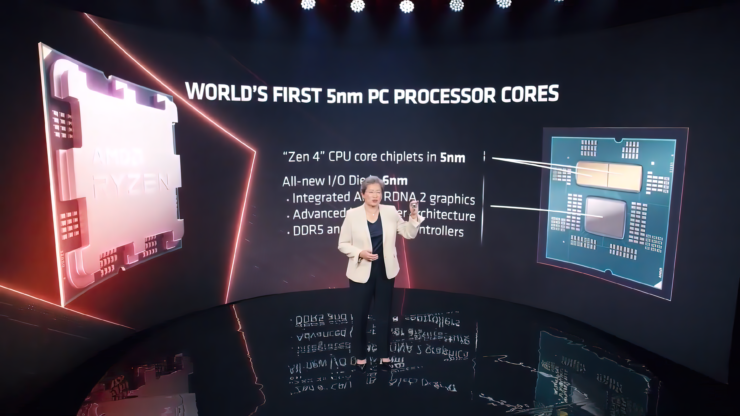
For DIY builders, the RDNA 2 iGPU can provide troubleshooting and diagnostic capabilities where users with graphics cards can debug if their graphics card is faulty or not or for other purposes. The same can be applied to users without graphics cards or those waiting on one who can't turn on their PC until they get their discrete GPU.
Frank Azor took the topic to a more interesting space by stating that while AMD Ryzen 7000 CPUs will have 'little graphics' cores compared to the 'bigger graphics' cores on APUs, they will still host some of the Smart Eco technologies boasted by notebooks. While AMD's RDNA 2 iGPUs can allow for sub-50W power usage in idle mode, Smart Shift on Desktop CPUs with RDNA 2 iGPUs can switch from discrete graphics to integrated graphics for light-weight workloads and offer sub-5W power or even mW power.
The other thing is that, unlike AMD's Navi 24 GPUs, the Ryzen 7000 iGPU based on the same RDNA 2 core architecture (but on a 6nm Rembrandt revision) will come with a VCN engine that supports both AV1 Video Encode and Decode.
We still think of the Ryzen 7000 series as a CPU. The graphics cores in that IO die are not many, the purpose of adding graphics is three-fold. One, it greatly expands these products in the commercial market where they don't buy discrete at all, they just want to turn it on, have video encode/decode and light up some displays for office work and that's what the GPU in the IO die will offer so that's a huge business opportunity for us on the Ryzen PRO side as we start migrating these components over to that business.
The second is for diagnostic purposes, how do you know that you have a bad graphics card? Well, you have to swap in another graphics card but with the graphics core we have, you can do a little bit of troubleshooting thirdly, we were thinking about users who are planning to buy a discrete graphics, and it's still in transit in the mail but all the other hardware has arrived first so it's all sat there, looking at a pile of components and don't have a GPU to actually set that all up. That would go away with the Ryzen 7000 series.
We are still going to do APUs with big graphics so APUs 'BIG GRAPHICS', CPUs 'little graphics'. That would be our strategy going forward.
Robert Hallock (AMD Director of Technical Marketing)
We are developing a lot of technologies that make use of integrated graphics in many ways and there are things that we are able to do with technologies such as Smart Shift ECO where we can turn off the discrete graphics and we can run the notebook off of the iGPU and say you want that because you want less heat, longer battery life (even when you are playing a game) or you want less fan noise or lower power consumption, there's all these benefits to it. Because we have that thin integrated graphics in Ryzen 7000 series, it's going to allow us to bring more of these types of smart technologies over to the desktops aswell so those customers can get some of these benefits.
Frank Azor (Chief Architect of Gaming Solutions)
As for whether we will see an iGPU disabled variant of Ryzen 7000 Desktop CPUs, Robert did state that all Zen 4 chips will have integrated RDNA 2 graphics so those in hopes of seeing a 'KF-esque' variant should be a bit disappointed.

The AMD Ryzen 7000 Desktop CPUs will feature a perfect square shape (45x45mm) but will house a very chonky integrated heat spreader or IHS. The CPUs will be the same length, width, and height as the existing Ryzen Desktop CPUs and are sealed across the sides so applying thermal paste won't fill the interior of the IHS with TIM. That's also why current coolers will be fully compatible with Ryzen 7000 chips.
As for TDP requirements, the AMD AM5 CPU platform will feature six different segments starting with the flagship 170W CPU class which is recommended for Liquid coolers (280mm or higher). It looks like this will be an aggressively clocked chip with higher voltages and with CPU overclocking support. This segment is followed by 120W TDP CPUs which are recommended to utilize a high-performance air-cooler. Interestingly, the 45-105W variants are listed as SR1/SR2a/SR4 thermal segments which means they would require standard heatsink solutions when running in a stock configuration so not much else is required to keep them cool.
First of all, the TDP (Thermal Dissipation Power) figures for AMD Ryzen 7000 CPUs are going to be up to 170W while the PPT (Package Power Tracking) is going to be 230W. AMD provided this information in a reply to whether the 170W figure was an actual TDP for the upcoming chips or an upper-bound limit for the package.
As per AMD, this is an increase of around 88W over the AM4 package power limit (PPT) which was 142W while the CPUs had a TDP of 105W. According to AMD, motherboard manufacturers will now be able to deploy more premium power characteristics on their motherboards which should allow for better overclocking opportunities for enthusiasts and overclockers.
"AMD would like to issue a correction to the socket power and TDP limits of the upcoming AMD Socket AM5. AMD Socket AM5 supports up to a 170W TDP with a PPT up to 230W.TDP*1.35 is the standard calculation for TDP v. PPT for AMD sockets in the “Zen” era, and the new 170W TDP group is no exception (170*1.35=229.5).
"This new TDP group will enable considerably more compute performance for high core count CPUs in heavy compute workloads, which will sit alongside the 65W and 105W TDP groups that Ryzen is known for today. AMD takes great pride in providing the enthusiast community with transparent and forthright product capabilities, and we want to take this opportunity to apologize for our error and any subsequent confusion we may have caused on this topic." --AMD Representative to Tom's Hardware (emphasis added)
AMD spokesperson viaTomshardware
So what we want to clarify is that it's a 170 Watt socket power which with AMD, that spec is PPT (Package Power) for us. That doesn't mean that every CPU is going to go up to 170 Watts but it's 30 (Watt) higher than the socket AM4 power cap which was a 142 (watts). And we did this to mainly improve multi-thread performance as many of the core count chips were actually held back in overall compute performance by relatively modest socket power.
The other point that I want to make is that by raising the minimum required socket power or minimum spec, you also raise the power delivery with every motherboard built to that spec so you get more robust power characteristics on all the boards which we are pretty excited about as well, It should be good for people who want to experiment with overclocking, people who appreciate premium board designs.
Robert Hallock (AMD Director of Technical Marketing)
AMD Ryzen 7000 Desktop 'AM5 LGA 1718 Socket' TDP Segments:
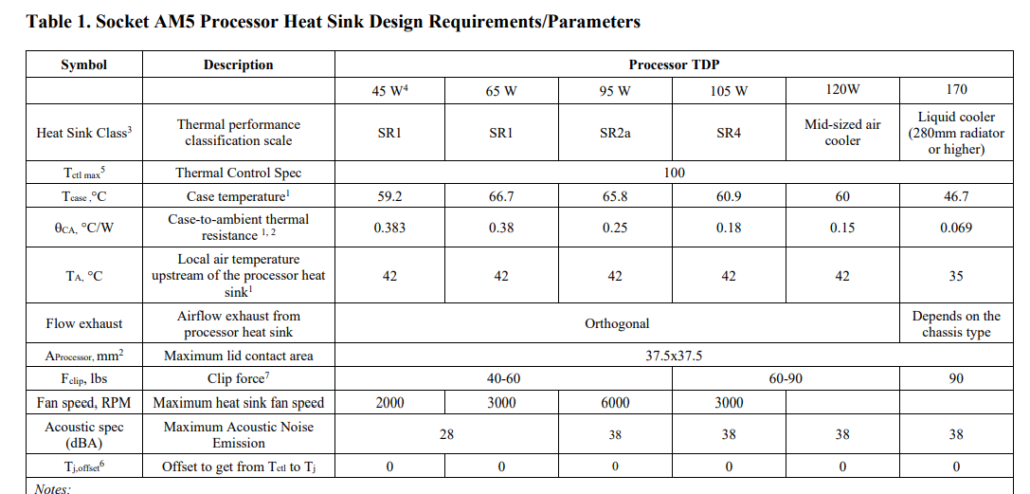
The Ryzen 7000 Desktop CPUs are also expected to feature RDNA 2 onboard graphics which means that just like Intel's mainstream desktop lineup, AMD's mainstream lineup will also feature iGPU graphics support. In regards to how many GPU cores there will be on the new chips,rumors say anywhere from 2-4(128-256 cores) clocked at up to 1100 MHz for up to 0.5 TFLOPs of horsepower. This will be lesser than the RDNA 2 CU count featured on the soon-to-be-released Ryzen 6000 APUs 'Rembrandt' but enough to keep Intel's Iris Xe iGPUs at bay.

During the Financial Analyst Day 2022, AMDconfirmedsome additional details regarding its Zen 4 core architecture such as IPC improvements and upcoming variants. According to AMD, Zen 4 has a 25% uplift in performance per watt and 35% overall performance uplift over Zen 3 when tested in the Cinebench R23 (nT) benchmark. The company states that Zen 4 offers:
- Significant generational performance per watt and frequency improvement
- 8-10% IPC increase
- 15% single-thread performance gain
- Up To 125% memory bandwidth per core
- ISA extensions for AI and AVX-512
Furthermore, it is alsoconfirmedthat Zen 4 will come in 3D V-Cache flavors as early as late 2022. It is not said what core counts we can expect in 3D V-Cache flavors but they will definitely be tackling Intel's 13th Gen Raptor Lake CPU lineup.
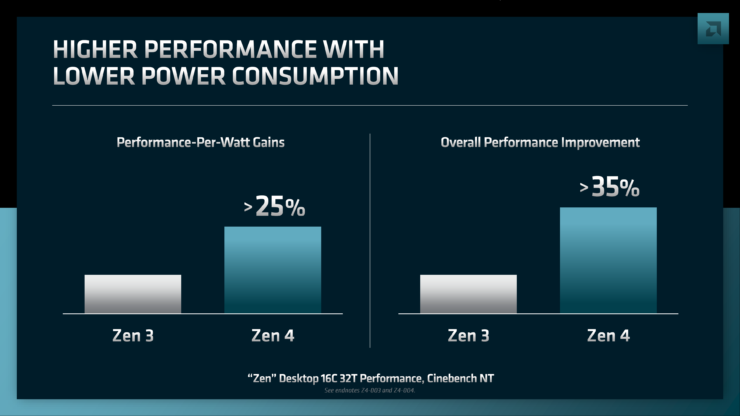
AMD Ryzen 7000 'Raphael' Desktop CPU 'Preliminary' Specs:
| CPU Name | Architecture | Process Node | Cores / Threads | Core Clock (SC Max) | Cache | TDP | Price |
|---|---|---|---|---|---|---|---|
| AMD Ryzen 9 7950X | Zen 4 | 5nm | 16/32 | ~5.5 GHz | 80 MB (64+16) | 105-170W | ~$700 US |
| AMD Ryzen 9 7900X | Zen 4 | 5nm | 12/24 | ~5.4 GHz | 76 MB (64+12) | 105-170W | ~$600 US |
| AMD Ryzen 7 7800X | Zen 4 | 5nm | 8/16 | ~5.3 GHz | 40 MB (32+8) | 65-125W | ~$400 US |
| AMD Ryzen 7 7700X | Zen 4 | 5nm | 8/16 | ~5.3 GHz | 40 MB (32+8) | 65-125W | ~$300 US |
| AMD Ryzen 5 7600X | Zen 4 | 5nm | 6/12 | ~5.2 GHz | 38 MB (32+6) | 65-125W | ~$200 US |
AMD Ryzen 7000 'Zen 4' CPUs Performance
The only performance demo that AMD has provided is that of a pre-production Ryzen 7000 CPU running at over 5 GHz across all cores (undisclosed amount) at 1080p. Just to give you an idea, current AMD Ryzen 5000 Desktop CPUs peak at around 4.8 GHz across all cores with a few samples hitting just under 4.9 GHz. A 5.0 GHz all-core boost in a pre-production unit means that we are most likely going to see AMD finally hitting that sweet 5 GHz+ core clock in both single and all-core workloads which is very impressive.
See AMD Ryzen 7000 and Zen 4 in action with Halo Infinite! With beautiful gameplay and high framerates, AMD is excited to bring you the ultimate PC and gaming experiences.#AMD2022https://t.co/4GRGyPgedCpic.twitter.com/R6jEPOGxV6
— AMD Ryzen (@AMDRyzen)January 4, 2022
AMD hasn't disclosed full performance metrics yet but considering how a 3D V-Cache uplift has put Ryzen back on track with Intel's 12th Gen lineup, Ryzen 7000 has all the bells and whistles to counter not only Intel's 12th Gen but also the 13th Gen Raptor Lake parts which are scheduled to launch around the same time as Raphael.
These are small details that make up a bigger part. So coming to the next part, we have to talk about the Blender demo. Blender is one application where AMD has a strong foothold. AMD's Ryzen 9 5950X is about 15-20% faster in the same benchmark versus the Intel Core i9-12900K. During the demo, AMD stated that the Ryzen 7000 Desktop CPU was 31% faster than 12900K. What's not told is that in the footnotes, the difference is larger with AMD finishing the render in a total of 204 seconds while the Alder Lake CPU finishes the demo in 297 seconds. In reality, the Ryzen 7000 CPU took 31% less time or offered 45% faster performance than the competing chip.
RPL-003:Testing as of May 5, 2022, by AMD Performance Labs using pre-production silicon and performance projections for final products which are subject to change when released on market. Render time measured in seconds to complete and AMD Ryzen 7000 series processor wallpaper render. AMD Time: 204 seconds, Intel time: 297 seconds. Lower score is better. Core i9-12900K System: ASUS ROG Maximus Z690 HERO, 2x16 DDR5-6000CL30. AMD Ryzen 7000 series (pre-production 16-core): AMD Reference X670 Motherboards, 2x16GB DDR5-6400CL32. All systems configured with Radeon RX 6950 XT (driver:22.10 PRIME), Windows 11 Build 22000.593, Samsung 980 PRO 1TB, Asetek 280MM Liquid cooler. Results may vary.
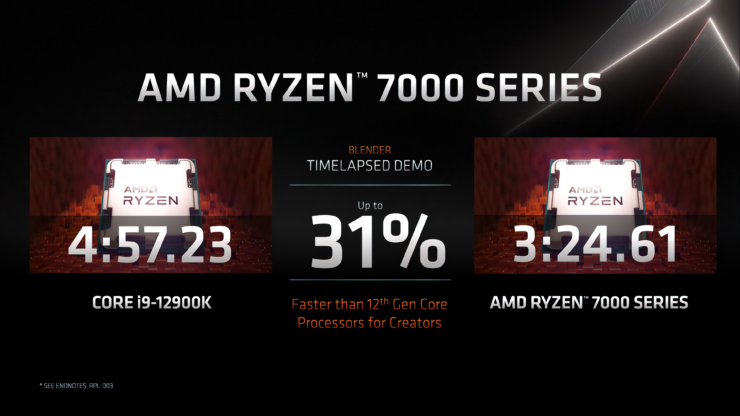
As for the 5.5 GHz clock speed gaming demo, Robert reassured that the frequencies were entirely on stock spec. The motherboard used was a reference X670 design and the cooling was a standard ASETEK 280mm AIO cooler. It is also obvious that no overclocking was involved since the clocks varied between 5.1 to 5.5 GHz.
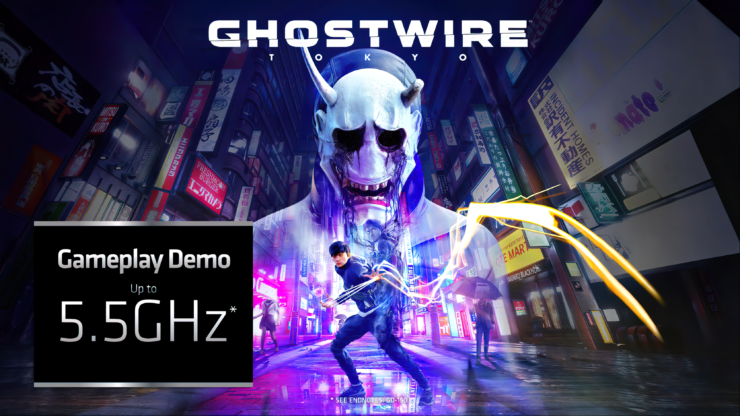
AMD showcased some insanely fast frequencies with the same Ryzen 7000 CPU sample hitting up to 5.52 GHz but we did see some variation in the clock speeds which started at 5.1 GHz and went up to the max 5.52 GHz speed which everyone is talking about. Interestingly, Robert states that in the respective game demo, they saw most of the threads clocking up to 5.5 GHz (that's 32 threads for the prototype that was used). The 16-core Ryzen 7000 prototype was produced around Late April or Early May so AMD could still squeeze more headroom out of this chip if they want to or just let overclockers do the job. Since then, there have been reports that AMD's Ryzen 7000 CPUs have amaximum frequency limit of up to 5.85 GHz.
AMD Ryzen 7000 16-Core Pre-Production Sample 'Gaming' Clocks!
We used a 280mm (ASETEK) watercooler so nothing exotic it's just a dual 140 loop that you can buy from Amazon or Newegg. It was running an AMD reference motherboard so one of our internal AM5 socket motherboards, a 16 core prototype part built in late April or early May and we just plugged it in and ran it. It was not an overclocked part, its just the natural frequency of that particular prototype.
So in the game, we were running most of the threads around 5.5 (GHz), it depends on the game load, depends on the scene, of course, clock speed fluctuates up and down so somewhere between 5.2 and 5.5 is pretty common on all the threads playing that game. So I wanna reassure people that this was nothing exotic in terms of cooling and nothing exotic in terms of parts selection or config or overclocking. It is exactly what you see, you plug in a Ryzen 7000 series part and play the game, & that's the frequency!
Robert Hallock (AMD Director of Technical Marketing)
Recentlyleaked benchmarkshave shown a 6 Core AMD Ryzen 5 7600X with a 4.4 GHz base clock beating the 16 core Ryzen 9 5950X in Basemark benchmark with up to 10% better performance.

AMD Ryzen 7000 'Zen 4' CPUs Pricing
Pricing is a much bigger topic to discuss this time around as we saw with AMD Ryzen 5000 CPUs. The Vermeer chips saw a bump in prices across all segments which were not welcomed by the PC consumers but still managed to break record sales figures,shipping over a million units in the first few months. AMD knows that they have the upper hand over Intel in terms of performance & that users are willing to pay the extra for their chips. As such, we can expect a similar or another bump in prices for AMD's Ryzen 7000 CPUs.
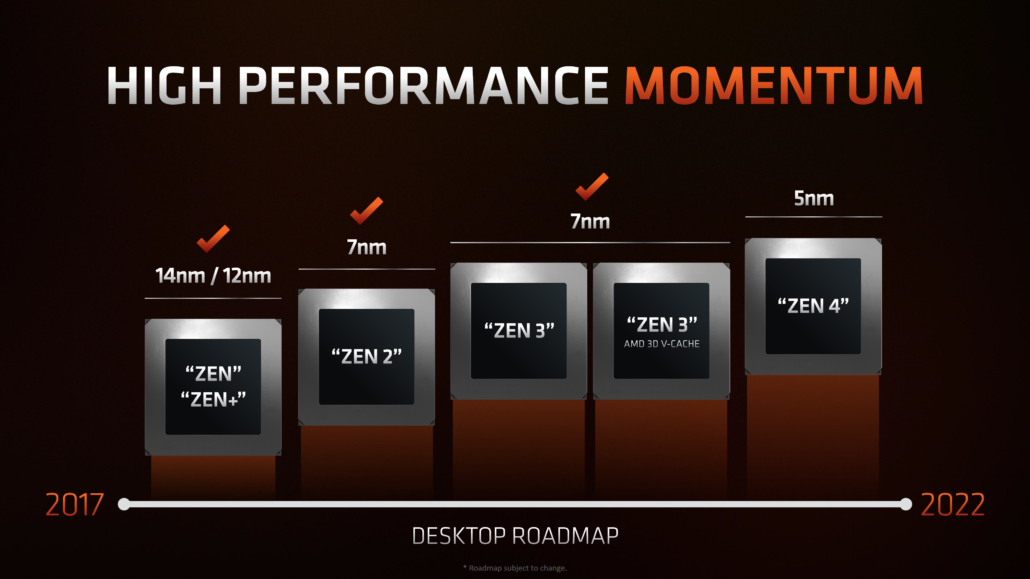
Arecent report from industry expertssuggests that TSMC is aiming to hike the prices of high-end CPUs by up to 20% this year. This is due to the complexities of the advanced 5nm process node due to several external factors, such as the continued high shipping and Foundry costs. The price increase is going to offset these variables and external factors that have affected the existing chip production process. And while there's a possibility that availability will get better for several of these product lines by the end of 2022, there's no confirmation if prices will get any better and that's the main concern for many right now.
Just for comparison's sake, the following is the price bump of Ryzen 5000 CPUs versus Ryzen 3000 CPUs:
- Ryzen 9 3950X - $749 US - Ryzen 9 5950X - $799 US(7% Increase)
- Ryzen 9 3900X - $499 US - Ryzen 9 5900X - $549 US(10% Increase)
- Ryzen 7 3800X - $399 US - Ryzen 7 5800X - $449 US(13% Increase)
- Ryzen 5 3600X - $249 US - Ryzen 5 5600X - $299 US(20% Increase)
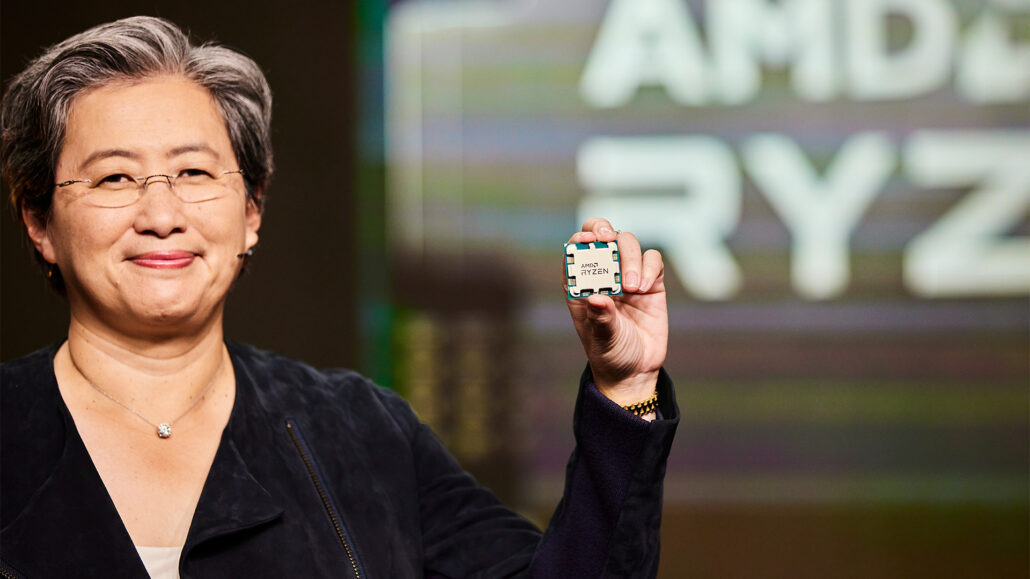
The current Ryzen flagship, the Ryzen 9 5950X costs $799.99 US and can be found on retail for around $700-$750 (discounted prices) even after more than a year since launch. The $800 US price tag is already the enthusiast category & anything more will be a hard pill to swallow for consumers but that's just where the whole tech industry is at right now.
AMD Ryzen 7000 'Zen 4' CPUs Launch & Availability
Availability is something that AMD hasreaffirmedrecently. AMD's CEO has stated that we can expect Ryzen 7000 Desktop CPUs in Fall 2022. This will mark two years since the launch of AMD's Ryzen 5000 Desktop CPUs.
We have also confirmed the launch dates ourselves and it is official that the 15th September on-shelf date was indeed correct.
- Product announcement:August 29, 2022 at 7:00PM ET / August 30, 2022 at 1:00AM CET / 7:00AM TW
- Press embargo:September 13, 2022 at 9AM ET / 3PM CET / 9PM TW
- Sales embargo:September 15, 2022 at 9AM ET / 3PM CET / 9PM TW
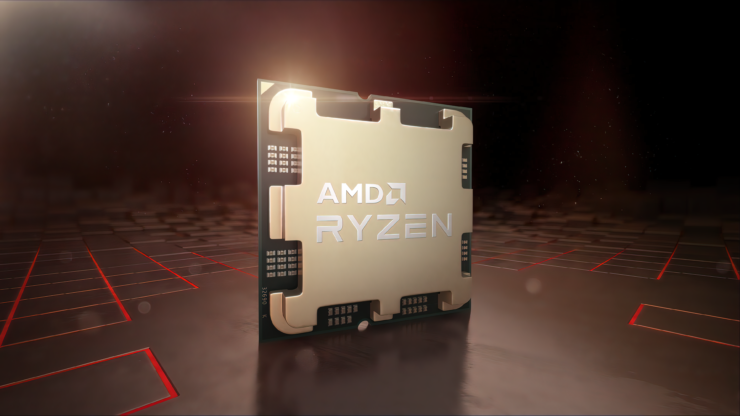
AMD Ryzen 5000 Desktop CPUsfaced severe supply shortageswhen they launched but things got better in the same quarter. Since TSMC's 5nm process node is being utilized by other vendors, we can expect a similar situation at launch.
AMD Ryzen 7000 Desktop CPU Render (With/Without IHS):
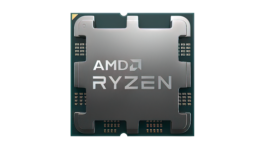

AMD Mainstream Desktop CPU Generations Comparison:
| AMD CPU Family | Codename | Processor Process | Processors Cores/Threads (Max) | TDPs (Max) | Platform | Platform Chipset | Memory Support | PCIe Support | Launch |
|---|---|---|---|---|---|---|---|---|---|
| Ryzen 1000 | Summit Ridge | 14nm (Zen 1) | 8/16 | 95W | AM4 | 300-Series | DDR4-2677 | Gen 3.0 | 2017 |
| Ryzen 2000 | Pinnacle Ridge | 12nm (Zen +) | 8/16 | 105W | AM4 | 400-Series | DDR4-2933 | Gen 3.0 | 2018 |
| Ryzen 3000 | Matisse | 7nm (Zen 2) | 16/32 | 105W | AM4 | 500-Series | DDR4-3200 | Gen 4.0 | 2019 |
| Ryzen 5000 | Vermeer | 7nm (Zen 3) | 16/32 | 105W | AM4 | 500-Series | DDR4-3200 | Gen 4.0 | 2020 |
| Ryzen 5000 3D | Warhol? | 7nm (Zen 3D) | 8/16 | 105W | AM4 | 500-Series | DDR4-3200 | Gen 4.0 | 2022 |
| Ryzen 7000 | Raphael | 5nm (Zen 4) | 16/32 | 170W | AM5 | 600-Series | DDR5-5200/5600? | Gen 5.0 | 2022 |
| Ryzen 7000 3D | Raphael | 5nm (Zen 4) | 16/32? | 105-170W | AM5 | 600-Series | DDR5-5200/5600? | Gen 5.0 | 2023 |
| Ryzen 8000 | Granite Ridge | 3nm (Zen 5)? | TBA | TBA | AM5 | 700-Series? | DDR5-5600+ | Gen 5.0 | 2024-2025? |
本文來源:WCCF Tech
AMD officially lifted the curtains off its next-generation Ryzen 7000 Dekstop CPUs that are going to feature the Zen 4 core architecture at CES 2022 & Computex 2022. The next-generation lineup will be bringing some drastic changes, not only limited to the CPU and we are going to talk about what you can expect in terms of specifications, performance, and prices. While Intel may have managed to take the performance, value, and efficiency throne from AMD with its 12th Gen Alder Lake lineup, AMD isn't going to sit silent. They have planned two brand new CPU launches this year with the upcoming one being a demonstration of how 3D V-Cache can allow gamers to benefit from faster performance in a mainstream package. But that's just one chip, the bigger launch is scheduled for the second half of 2022 in the form of Ryzen 7000 and it's going to fundamentally change everything for the Ryzen Desktop CPU platform. AMD Ryzen 'Zen 4' Desktop CPU Expected Features: Before we talk CPUs, we have to talk about the platform itself. The AMD Ryzen 7000 CPUs will be migrating to a new home known as AM5, the successor to the long-lasting AM4 platform. It marks a fresh start for the Ryzen Desktop family and as such, existing Ryzen CPUs starting with Ryzen 1000 & all the way up to Ryzen 5000 won't be supported by the new platform and we will tell you why it is so. The AM5 platform will first and foremost feature the brand new LGA 1718 socket. That's correct, AMD isn't going the PGA (Pin Grid Array) route anymore and now focusing on LGA (Land Grid Array), similar to what Intel uses on its existing desktop processors. The main reason to go LGA is due to the addition of enhanced and next-gen features such as PCIe Gen 5, DDR5, etc that we will get to see on the AM5 platform. The socket has a single latch & gone are the days of worrying about pins underneath your precious processors. In terms of features, the AM5 platform will initially support AMD's Ryzen 7000 'Zen 4' Desktop CPUs and extend that support to future Ryzen CPUs and APUs. The platform offers DDR5-5200 (JEDEC) memory support, up to 28 PCIe lanes (Gen 5 standard), increased NVMe 4.0, and USB 3.2 I/O lanes & we have also heard chatter about native USB 4.0 support which will be a game-changer. A new feature called EXPO (AMD Extended Profiles for overclocking) will allow enhanced DDR5 memory OC on the new platform, similar to Intel's XMP. It has been a rough road for AM4 to offer decent DDR4 OC capabilities but that has more or less been sorted out by now, we can only expect DDR5 to have a much better OC and compatibility experience compared to DDR4 on AM4 platforms. Furthermore, it looks like the platform will only be DDR5 compatible and we won't see DDR4 options as we do on Intel's existing platform. But with DDR5 prices and availability improving, that won't be that big of a deal for most high-end consumers for who AMD will be aiming first. AMD X670 Series Platform The AM5 compliant AMD 600-series motherboards are currently being prepped up by the board makers, The 600-series lineup will initially consist of three chipsets, the X670E, X670, B650E, and B650. In terms of features, the X670E (Extreme) is designed for the higher-echelon of motherboards with unparalleled capabilities, and extreme overclocking, and will have PCIe 5.0 support for both GPU and storage. The X670 motherboards will be very similar in offering enthusiast-level overclocking but PCIe Gen 5.0 support for storage and graphics will depend on manufacturers. It is likely that some board makers will go to the cost-effective route and enable PCIe 5.0 support only for the GPU while keeping storage limited to PCIe 4.0. Both X670 chipsets will come in a dual-PCH solution on the motherboard to allow for the increased I/O for the next-gen platform. AMD B650 Series Platform Finally, there are the B650E & B650 chipsets which will be aimed as a mainstream motherboard solution with the Extreme series featuring both PCIe Gen 5.0 and M.2 while the non-E boards will adopt only PCIe 5.0 slot designs. The B650 motherboards will be the successor to the B550 motherboards and come in a similar price range. Compared to the X670/E offerings, the B650 chipset will come in a single PCH design. The motherboards will carry support for RDNA 2 iGPU too which will be featured on Ryzen 7000 'Raphael' CPUs and offer both HDMI / DP outputs. One of the highlighted features of the AMD AM5 600-series platform is SAS or Smart Access Storage. This technology will enable GPU decompression with supported Microsoft DirectStorage games. Although there aren't many of those out there yet but expect industry-wide support for this on newer platforms. As for longevity, AMD hasn't promised anything but they have stated that they want to see the new AM5 socket last at least four to five years, similar to AM4. While there has been a lot of controversy regarding Ryzen support on the initial AM4 motherboards, I believe that AMD has learned and will not follow the same route with AM5. With that said, the AM4 platform will still continue forward & will be supported in the foreseeable future (possibly with newer hardware and software launches). Traditional game loading takes a significant amount of compute power to decompress the game’s data, requiring the CPU to do the decompression and data transfer, which introduces latency and takes up considerable system resources. To help bypass these bottlenecks, AMD has created SmartAccess Storage, a suite of technologies supporting Microsoft DirectStorage that utilizes Smart Access Memory with new AMD platform technologies along with Radeon GPU asset decompression to improve both game load times and texture streaming. Coming to the CPUs now, we have managed to get hold of the final specifications of AMD's Ryzen 7000 Desktop CPU family which, as expected, are going to feature four SKUs based on the Zen 4 core architecture. Once again, these SKUs include: So before getting into the core specifications, we have to point out that the AMD Zen 4 architecture brings with it a 8-10% IPC uplift but the majority of the performance benefit comes from the higher clock speeds and a higher TDP that is supplemented to each chip versus the prior generation. AMD has highlighted a >15% Single-Threaded, >35% Multi-Threaded and >25% Perf/Watt increases when comparing Zen 4 to Zen 3 cores. The CPUs will come with an optimized cache restructuring, featuring double the L2 cache (1 MB vs 512 KB), a shared L3 cache like the previous generation, support for DDR5 memory with EXPO (AMD's Extended Profiles For Memory Overclocking), PCIe Gen 5.0 graphics card, and M.2 SSD support. So with all of that said, let's get on with the specifications. Starting with the flagship of them all, we have the AMD Ryzen 9 7950X which retains its healthy 16 core and 32 thread count from the previous two generations. The CPU will feature an impressive base frequency of 4.5 GHz and a boost clock of up to 5.7 GHz which should make it 200 MHz faster than Intel's Alder Lake Core i9-12900KS which has a boost frequency of 5.5 GHz on a single-core. It looks like AMD is extracting every ounce of Hertz that it could within that 170W TDP (230W PPT) for the Ryzen 9 chips. As for the cache, the CPU comes with 80 MB of that which includes 64 MB from L3 (32 MB per CCD) and 16 MB from L2 (1 MB per core). We don't know the pricing or performance of the Ryzen 9 7950X yet but based on the clocks alone, it should be a worthy successor to the Ryzen 9 5950X and will easily be able to topple Intel's current Core i9-12900K CPU. Next up, we have another AMD Ryzen 9 chip, the 7900X, which as the name suggests, would come equipped with 12 cores and 24 threads. The CPU comes with an even higher base clock of 4.7 GHz and a boost clock adjusted at 5.6 GHz across a single core. The CPU retains its 170W TDP and gets 76 MB of cache (64 MB L3 + 12 MB L2). The CPU will be positioned in the same ballpark as the AMD Ryzen 9 5900X but with performance that would shake the ground from below the Core i7-12700K. Moving over to the Ryzen 7 family, here we have the AMD Ryzen 7 7700X, an 8-core and 16-thread part. AMD positions this as the sweet spot for gamers and as such, the CPU will feature base clock of 4.5 GHz and a boost clock of 5.4 GHz but at a lower 105W TDP (142W PPT). The CPU will get a 40 MB cache pool which consists of 32 MB L3 from the singular CCD &8 MB L2 from the Zen 4 cores. Now one interesting thing to mention is that there is so far no update by AMD on a Ryzen 7 7800X chip. It is likely that AMD wants to replace that part with a successor to the Ryzen 7 5800X3D with Zen 4 cores (3D V-Cache). If that was the case, we can expect an update later this year to the CPU lineup since the V-Cache parts have been confirmed for a late Q4 2022 launch by AMD themselves. Also, based on the segmentation alone, it looks like the Ryzen 7 7700X will be priced really well in the mainstream segment. Last up, we have the most budget-tier chip (if you can call it that but the pricing won't be reflective of that), the Ryzen 5 7600X. This will be a 6-core and a 12-thread part that features a high 4.7 GHz base clock and a 5.3 GHz single-core boost frequency. The CPU will also run at a 105W TDP (142W PPT) which is much higher than its 65W predecessor though once again, that's the sacrifice you've to pay to achieve the faster clock speeds. The CPU will carry 38 MB of cache that comes from 32 MB of L3 and 6 MB of L2 on the die. Users Only Allowed To Undervolt AMD Ryzen 7000 Desktop CPUs? We have one more crucial piece of information that we were able to learn. According to the same sources, the AMD Ryzen 7000 Desktop CPUs based on the Zen 4 core architecture may only allow users to undervolt the chip itself. This would be similar to the Ryzen 7 5800X3D which also had a voltage limit that wasn't meant to be exceeded. It looks like AMD may already be running the CPUs at a high enough voltage to achieve the higher clock speeds that there might be little to no room left for further overclocking. We have heard about the 5.85 GHz frequency limit before and that leaves the top parts with just 150 MHz to work with. With that said, we have seen AMD mention Extreme and Enthusiast overclocking for their X670E and X670 class motherboards. That might be in relation to DDR5 memory but that remains to be seen. I personally believe that overclocking such as PBO will be available but limited to some extent on the first AM5 generation. The CPUs will also come equipped with RDNA 2 iGPU which would be usable through HDMI 2.1 FRL and DP 1.4 connectors on the latest AM5 motherboards. In addition to the CPU & GPU, there will be an expanded instruction set for AI acceleration (AVX-512 anyone?). As for what the new RDNA 2 iGPUs on the Ryzen 7000 Desktop CPUs bring to the table, AMD states that with integrated graphics on their entire CPU portfolio, they can expand their business into the commercial segment and that makes a lot of sense since a lot of consumers there don't require a discrete graphics card and want something that is as simple as plug-and-play. For DIY builders, the RDNA 2 iGPU can provide troubleshooting and diagnostic capabilities where users with graphics cards can debug if their graphics card is faulty or not or for other purposes. The same can be applied to users without graphics cards or those waiting on one who can't turn on their PC until they get their discrete GPU. Frank Azor took the topic to a more interesting space by stating that while AMD Ryzen 7000 CPUs will have 'little graphics' cores compared to the 'bigger graphics' cores on APUs, they will still host some of the Smart Eco technologies boasted by notebooks. While AMD's RDNA 2 iGPUs can allow for sub-50W power usage in idle mode, Smart Shift on Desktop CPUs with RDNA 2 iGPUs can switch from discrete graphics to integrated graphics for light-weight workloads and offer sub-5W power or even mW power. The other thing is that, unlike AMD's Navi 24 GPUs, the Ryzen 7000 iGPU based on the same RDNA 2 core architecture (but on a 6nm Rembrandt revision) will come with a VCN engine that supports both AV1 Video Encode and Decode. We still think of the Ryzen 7000 series as a CPU. The graphics cores in that IO die are not many, the purpose of adding graphics is three-fold. One, it greatly expands these products in the commercial market where they don't buy discrete at all, they just want to turn it on, have video encode/decode and light up some displays for office work and that's what the GPU in the IO die will offer so that's a huge business opportunity for us on the Ryzen PRO side as we start migrating these components over to that business. The second is for diagnostic purposes, how do you know that you have a bad graphics card? Well, you have to swap in another graphics card but with the graphics core we have, you can do a little bit of troubleshooting thirdly, we were thinking about users who are planning to buy a discrete graphics, and it's still in transit in the mail but all the other hardware has arrived first so it's all sat there, looking at a pile of components and don't have a GPU to actually set that all up. That would go away with the Ryzen 7000 series. We are still going to do APUs with big graphics so APUs 'BIG GRAPHICS', CPUs 'little graphics'. That would be our strategy going forward. Robert Hallock (AMD Director of Technical Marketing) We are developing a lot of technologies that make use of integrated graphics in many ways and there are things that we are able to do with technologies such as Smart Shift ECO where we can turn off the discrete graphics and we can run the notebook off of the iGPU and say you want that because you want less heat, longer battery life (even when you are playing a game) or you want less fan noise or lower power consumption, there's all these benefits to it. Because we have that thin integrated graphics in Ryzen 7000 series, it's going to allow us to bring more of these types of smart technologies over to the desktops aswell so those customers can get some of these benefits. Frank Azor (Chief Architect of Gaming Solutions) As for whether we will see an iGPU disabled variant of Ryzen 7000 Desktop CPUs, Robert did state that all Zen 4 chips will have integrated RDNA 2 graphics so those in hopes of seeing a 'KF-esque' variant should be a bit disappointed. The AMD Ryzen 7000 Desktop CPUs will feature a perfect square shape (45x45mm) but will house a very chonky integrated heat spreader or IHS. The CPUs will be the same length, width, and height as the existing Ryzen Desktop CPUs and are sealed across the sides so applying thermal paste won't fill the interior of the IHS with TIM. That's also why current coolers will be fully compatible with Ryzen 7000 chips. As for TDP requirements, the AMD AM5 CPU platform will feature six different segments starting with the flagship 170W CPU class which is recommended for Liquid coolers (280mm or higher). It looks like this will be an aggressively clocked chip with higher voltages and with CPU overclocking support. This segment is followed by 120W TDP CPUs which are recommended to utilize a high-performance air-cooler. Interestingly, the 45-105W variants are listed as SR1/SR2a/SR4 thermal segments which means they would require standard heatsink solutions when running in a stock configuration so not much else is required to keep them cool. First of all, the TDP (Thermal Dissipation Power) figures for AMD Ryzen 7000 CPUs are going to be up to 170W while the PPT (Package Power Tracking) is going to be 230W. AMD provided this information in a reply to whether the 170W figure was an actual TDP for the upcoming chips or an upper-bound limit for the package. As per AMD, this is an increase of around 88W over the AM4 package power limit (PPT) which was 142W while the CPUs had a TDP of 105W. According to AMD, motherboard manufacturers will now be able to deploy more premium power characteristics on their motherboards which should allow for better overclocking opportunities for enthusiasts and overclockers. "AMD would like to issue a correction to the socket power and TDP limits of the upcoming AMD Socket AM5. AMD Socket AM5 supports up to a 170W TDP with a PPT up to 230W. TDP*1.35 is the standard calculation for TDP v. PPT for AMD sockets in the “Zen” era, and the new 170W TDP group is no exception (170*1.35=229.5). "This new TDP group will enable considerably more compute performance for high core count CPUs in heavy compute workloads, which will sit alongside the 65W and 105W TDP groups that Ryzen is known for today. AMD takes great pride in providing the enthusiast community with transparent and forthright product capabilities, and we want to take this opportunity to apologize for our error and any subsequent confusion we may have caused on this topic." -- AMD Representative to Tom's Hardware (emphasis added) AMD spokesperson via Tomshardware So what we want to clarify is that it's a 170 Watt socket power which with AMD, that spec is PPT (Package Power) for us. That doesn't mean that every CPU is going to go up to 170 Watts but it's 30 (Watt) higher than the socket AM4 power cap which was a 142 (watts). And we did this to mainly improve multi-thread performance as many of the core count chips were actually held back in overall compute performance by relatively modest socket power. The other point that I want to make is that by raising the minimum required socket power or minimum spec, you also raise the power delivery with every motherboard built to that spec so you get more robust power characteristics on all the boards which we are pretty excited about as well, It should be good for people who want to experiment with overclocking, people who appreciate premium board designs. Robert Hallock (AMD Director of Technical Marketing) AMD Ryzen 7000 Desktop 'AM5 LGA 1718 Socket' TDP Segments: The Ryzen 7000 Desktop CPUs are also expected to feature RDNA 2 onboard graphics which means that just like Intel's mainstream desktop lineup, AMD's mainstream lineup will also feature iGPU graphics support. In regards to how many GPU cores there will be on the new chips, rumors say anywhere from 2-4 (128-256 cores) clocked at up to 1100 MHz for up to 0.5 TFLOPs of horsepower. This will be lesser than the RDNA 2 CU count featured on the soon-to-be-released Ryzen 6000 APUs 'Rembrandt' but enough to keep Intel's Iris Xe iGPUs at bay. During the Financial Analyst Day 2022, AMD confirmed some additional details regarding its Zen 4 core architecture such as IPC improvements and upcoming variants. According to AMD, Zen 4 has a 25% uplift in performance per watt and 35% overall performance uplift over Zen 3 when tested in the Cinebench R23 (nT) benchmark. The company states that Zen 4 offers: Furthermore, it is also confirmed that Zen 4 will come in 3D V-Cache flavors as early as late 2022. It is not said what core counts we can expect in 3D V-Cache flavors but they will definitely be tackling Intel's 13th Gen Raptor Lake CPU lineup. The only performance demo that AMD has provided is that of a pre-production Ryzen 7000 CPU running at over 5 GHz across all cores (undisclosed amount) at 1080p. Just to give you an idea, current AMD Ryzen 5000 Desktop CPUs peak at around 4.8 GHz across all cores with a few samples hitting just under 4.9 GHz. A 5.0 GHz all-core boost in a pre-production unit means that we are most likely going to see AMD finally hitting that sweet 5 GHz+ core clock in both single and all-core workloads which is very impressive. See AMD Ryzen 7000 and Zen 4 in action with Halo Infinite! With beautiful gameplay and high framerates, AMD is excited to bring you the ultimate PC and gaming experiences. #AMD2022https://t.co/4GRGyPgedC pic.twitter.com/R6jEPOGxV6 — AMD Ryzen (@AMDRyzen) January 4, 2022 AMD hasn't disclosed full performance metrics yet but considering how a 3D V-Cache uplift has put Ryzen back on track with Intel's 12th Gen lineup, Ryzen 7000 has all the bells and whistles to counter not only Intel's 12th Gen but also the 13th Gen Raptor Lake parts which are scheduled to launch around the same time as Raphael. These are small details that make up a bigger part. So coming to the next part, we have to talk about the Blender demo. Blender is one application where AMD has a strong foothold. AMD's Ryzen 9 5950X is about 15-20% faster in the same benchmark versus the Intel Core i9-12900K. During the demo, AMD stated that the Ryzen 7000 Desktop CPU was 31% faster than 12900K. What's not told is that in the footnotes, the difference is larger with AMD finishing the render in a total of 204 seconds while the Alder Lake CPU finishes the demo in 297 seconds. In reality, the Ryzen 7000 CPU took 31% less time or offered 45% faster performance than the competing chip. RPL-003: Testing as of May 5, 2022, by AMD Performance Labs using pre-production silicon and performance projections for final products which are subject to change when released on market. Render time measured in seconds to complete and AMD Ryzen 7000 series processor wallpaper render. AMD Time: 204 seconds, Intel time: 297 seconds. Lower score is better. Core i9-12900K System: ASUS ROG Maximus Z690 HERO, 2x16 DDR5-6000CL30. AMD Ryzen 7000 series (pre-production 16-core): AMD Reference X670 Motherboards, 2x16GB DDR5-6400CL32. All systems configured with Radeon RX 6950 XT (driver:22.10 PRIME), Windows 11 Build 22000.593, Samsung 980 PRO 1TB, Asetek 280MM Liquid cooler. Results may vary. As for the 5.5 GHz clock speed gaming demo, Robert reassured that the frequencies were entirely on stock spec. The motherboard used was a reference X670 design and the cooling was a standard ASETEK 280mm AIO cooler. It is also obvious that no overclocking was involved since the clocks varied between 5.1 to 5.5 GHz. AMD showcased some insanely fast frequencies with the same Ryzen 7000 CPU sample hitting up to 5.52 GHz but we did see some variation in the clock speeds which started at 5.1 GHz and went up to the max 5.52 GHz speed which everyone is talking about. Interestingly, Robert states that in the respective game demo, they saw most of the threads clocking up to 5.5 GHz (that's 32 threads for the prototype that was used). The 16-core Ryzen 7000 prototype was produced around Late April or Early May so AMD could still squeeze more headroom out of this chip if they want to or just let overclockers do the job. Since then, there have been reports that AMD's Ryzen 7000 CPUs have a maximum frequency limit of up to 5.85 GHz. AMD Ryzen 7000 16-Core Pre-Production Sample 'Gaming' Clocks! We used a 280mm (ASETEK) watercooler so nothing exotic it's just a dual 140 loop that you can buy from Amazon or Newegg. It was running an AMD reference motherboard so one of our internal AM5 socket motherboards, a 16 core prototype part built in late April or early May and we just plugged it in and ran it. It was not an overclocked part, its just the natural frequency of that particular prototype. So in the game, we were running most of the threads around 5.5 (GHz), it depends on the game load, depends on the scene, of course, clock speed fluctuates up and down so somewhere between 5.2 and 5.5 is pretty common on all the threads playing that game. So I wanna reassure people that this was nothing exotic in terms of cooling and nothing exotic in terms of parts selection or config or overclocking. It is exactly what you see, you plug in a Ryzen 7000 series part and play the game, & that's the frequency! Robert Hallock (AMD Director of Technical Marketing) Recently leaked benchmarks have shown a 6 Core AMD Ryzen 5 7600X with a 4.4 GHz base clock beating the 16 core Ryzen 9 5950X in Basemark benchmark with up to 10% better performance. Pricing is a much bigger topic to discuss this time around as we saw with AMD Ryzen 5000 CPUs. The Vermeer chips saw a bump in prices across all segments which were not welcomed by the PC consumers but still managed to break record sales figures, shipping over a million units in the first few months. AMD knows that they have the upper hand over Intel in terms of performance & that users are willing to pay the extra for their chips. As such, we can expect a similar or another bump in prices for AMD's Ryzen 7000 CPUs. A recent report from industry experts suggests that TSMC is aiming to hike the prices of high-end CPUs by up to 20% this year. This is due to the complexities of the advanced 5nm process node due to several external factors, such as the continued high shipping and Foundry costs. The price increase is going to offset these variables and external factors that have affected the existing chip production process. And while there's a possibility that availability will get better for several of these product lines by the end of 2022, there's no confirmation if prices will get any better and that's the main concern for many right now. Just for comparison's sake, the following is the price bump of Ryzen 5000 CPUs versus Ryzen 3000 CPUs: The current Ryzen flagship, the Ryzen 9 5950X costs $799.99 US and can be found on retail for around $700-$750 (discounted prices) even after more than a year since launch. The $800 US price tag is already the enthusiast category & anything more will be a hard pill to swallow for consumers but that's just where the whole tech industry is at right now. Availability is something that AMD has reaffirmed recently. AMD's CEO has stated that we can expect Ryzen 7000 Desktop CPUs in Fall 2022. This will mark two years since the launch of AMD's Ryzen 5000 Desktop CPUs. We have also confirmed the launch dates ourselves and it is official that the 15th September on-shelf date was indeed correct. AMD Ryzen 5000 Desktop CPUs faced severe supply shortages when they launched but things got better in the same quarter. Since TSMC's 5nm process node is being utilized by other vendors, we can expect a similar situation at launch. AMD Ryzen 7000 Desktop CPU Render (With/Without IHS):